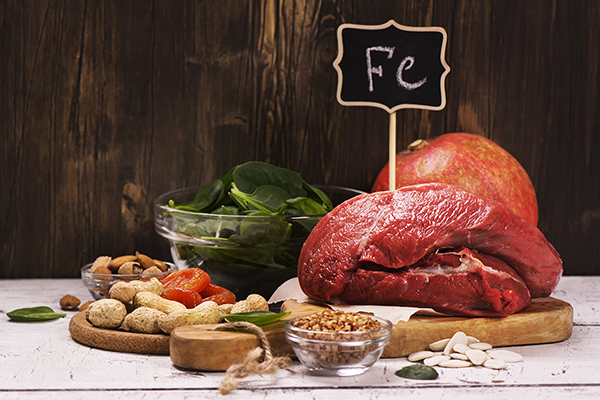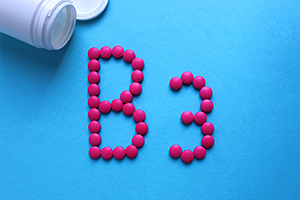



| By Dr. Ronald Hoffman

Iron is an essential nutrient, but it has its dark side as well. Deficiency is common, and can result in a multitude of problems. But excess iron also poses serious health risks.
Historical fact #1: The Lancet, the leading international medical journal, was so named after the common practice of bloodletting, which was felt to be a panacea for a variety of ailments. Bloodletting was first performed in ancient Egypt, and continued to be popular until the end of the 18th century. Typically, barbers, who possessed sharp instruments, were entrusted to perform the procedure. The traditional barbers’ pole, consisting of red and white stripes, symbolizes the juxtaposition of blood and bandages.
Historical fact #2 : Benjamin Rush, an original signatory of the Constitution, was a big believer in bloodletting. When George Washington developed a throat infection, Rush bled him. The estimated 3 to 4 liters of blood withdrawn from him in a ten hour period was said to have hastened his demise.
(Watch a truly hilarious SNL skit from 1978 featuring Steve Martin as “Theodoric of York” here)
While it is now acknowledged that the vast majority of the past’s bloodletting procedures were misguided, there persists a rationale for taming excess iron levels.
A condition called hemochromatosis afflicts 1% of people of Celtic or Scandinavian origin (the condition is less prevalent among people of other races and ethnicities).
The condition can cause cirrhosis of the liver, bronze skin, diabetes, arthritis, and heart muscle weakness. Excess iron acts as a free radical promoter, causing cellular “rust” (oxidation).
Ten percent of Celts and Scandinavians carry one of several genes that potentiate iron overload, but it may not cause overt problems. Nonetheless, one study showed the risk of heart attack was doubled over 9 years in carriers of a hemochromatosis gene.
Detecting hemochromatosis early is important, because once the damage has occurred it’s hard to reverse. Chelation with Desferal helps only a little. That’s why I frequently perform the ferritin blood test on patients, because it gives us a handle on both iron overload and iron deficiency (see below).
Genetic testing can clinch the diagnosis of hemochromatosis, but not all hemochromatosis gene carriers end up expressing the trait. Women, because they lose iron via menstruation and childbirth, may have a delayed onset of hemochromatosis, but it’s a mistake to presume that they are exempt from risk. The treatment for hemochromatosis is—you guessed it!—periodic bloodletting. Only these days, the hematologist has replaced the barber, and they use narrow gauge needles instead of blades.
Why did God and Nature program some people to get iron overload? After watching “The Vikings” on NatGeo, I thought the answer was because of all the sword-fighting. But actually, archaeologists have found a high prevalence of intestinal parasites in the remains of ancient people living in Northern Europe. Chronic parasitic infections are known to be a major cause of iron deficiency anemia, so the hemochromatosis gene probably gave its possessors a survival edge.
What about those without hemochromatosis? Can periodic blood donation provide them with health benefits (as long as they’re not iron-deficient)? Several studies suggest that regular blood donation lowers risk of heart attacks. A 2005 study from Yale University demonstrated that frequent blood donors had better vascular function.
But the Goldilocks Rule applies to iron, as it does to many essential nutrients: While too much is bad, too little is also a frequent cause of trouble, especially for younger women.
There are three levels of iron deficiency. The most serious is iron deficiency anemia, where there is a dearth of red blood cells, and they are small and pale, which can be detected from a CBC blood test.
More subtle is simple iron deficiency, which a standard chemistry blood test will reveal.
But even more insidious, and strikingly prevalent, is borderline iron insufficiency, which requires the ferritin blood test to disclose.
The classic manifestations of iron deficiency are fatigue and exercise intolerance. But iron deficiency may rob your IQ; it even accounts for a high percentage of Attention Deficit Disorder (ADD) among young girls.
Iron insufficiency is associated with hair thinning, brittle nails, insomnia, migraines, and restless leg syndrome.
What to do about iron levels?
Insist that your health practitioner use the ferritin blood test to pinpoint your status: Too much, too little, or just right.
Don’t be fooled by misleading blood tests: A test performed while you have an infection or an attack of an inflammatory disorder like ulcerative colitis or rheumatoid arthritis can yield a falsely reassuring, spuriously elevated ferritin; alternatively, these conditions may lower your serum iron, erroneously signaling a need for iron when you don’t need it.
If your iron levels are high, get a genetic test for hemochromatosis. If confirmed, get appropriate treatment—elective phlebotomy—from a hematologist.
If you’re a healthy male or post-menopausal female with adequate iron, consider giving blood twice yearly. It’s simultaneously altruistic and selfish!
If your iron is low, start by upping your intake of heme iron, the most bio-available source, from red or organ meat.
That’s what I did when I suffered from profound iron deficiency after a hip fracture I sustained 10 years ago. My blood counts declined to half normal—almost transfusion level. I tried strong prescription iron supplements, but coupled with the hip discomfort I experienced sitting on the toilet and the bowel-slowing effects of the pain meds I was taking, their constipating effects were intolerable. So my family members stocked my larder with lamb, beef, and liver, which I consumed liberally. Within two months, my blood counts were restored to normal.
While spinach and other greens are reputed to be iron-rich, their plant-based iron is poorly absorbed (Popeye was wrong!).
If you’re a committed vegetarian, you can take supplements, but beware of ferrous sulfate, which may slow your intestinal transit to a crawl. Consider iron bisglycinate or Ferronyl. which are gentler, but of relatively lower potency.
If you’re low in iron, vitamin C can enhance its absorption; but avoid excess black tea, which can deplete it. And certain medications, like acid-blockers and aspirin, can lower lower iron.
Sufferers of ulcerative colitis and Crohn’s disease, while prone to iron deficiency, don’t do well with iron pills because they have an irritating effect on their inflamed intestinal walls. If they can’t restore their depleted iron levels with food, they are candidates for intravenous iron which bypasses the GI tract.
Keep in mind that anemia sometimes doesn’t just call for more iron; if diagnosed with anemia that is severe or doesn’t respond within a few months to an iron-rich diet or supplements, you need a workup. That may involve special blood tests, scoping from above and/or below, or even a bone marrow biopsy.
Ordinary persons should avoid taking supplemental iron unless recommended by a knowledgeable health professional. That includes multis with iron (except for pregnant women using prenatal supplements, which usually include small amounts of iron).
Follow the above guidelines to make sure your iron levels are “just right.”
Though we think of declining estrogen as the hallmark of menopause, it's actually common for…

Up to 12 percent of Americans have ulcers at some point in life. Peptic ulcers…
Gallbladder disease is a modern illness. An estimated 20 million Americans have gallbladder disease. The…

This past week we were regaled with headlines like: High levels of niacin may increase…

March is National Nutrition Month and, needless to say, good nutritious food is essential to…

I recently attended the Integrative Healthcare Symposium (IHS), an annual conference held here in Manhattan. The…

Q&A with Leyla, Part 1: A Nicotine Vaccine

Our virtual voicemail is open 24/7, so there's no need to wait to submit your questions for Dr. Hoffman. Leave a message, and you may hear your question featured on the Intelligent Medicine radio program!